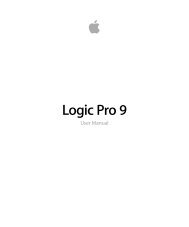Soundtrack Pro 3 Effects Reference (en).pdf - Help Library - Apple
Soundtrack Pro 3 Effects Reference (en).pdf - Help Library - Apple
Soundtrack Pro 3 Effects Reference (en).pdf - Help Library - Apple
Create successful ePaper yourself
Turn your PDF publications into a flip-book with our unique Google optimized e-Paper software.
126 Chapter 10 Reverb <strong>Effects</strong><br />
Plates, Digital Reverb <strong>Effects</strong>, and Convolution Reverb<br />
The first form of reverb used in music production was actually a special room with hard<br />
surfaces, called an echo chamber. It was used to add echoes to the signal. Mechanical<br />
devices, including metal plates and springs, were also used to add reverberation to the<br />
output of musical instrum<strong>en</strong>ts and microphones.<br />
Digital recording introduced digital reverb effects, which consist of thousands of delays<br />
of varying l<strong>en</strong>gths and int<strong>en</strong>sities. The time differ<strong>en</strong>ces betwe<strong>en</strong> the original signal and<br />
the arrival of the early reflections can be adjusted by a parameter commonly known as<br />
predelay. The average number of reflections in a giv<strong>en</strong> period of time is determined by<br />
the d<strong>en</strong>sity parameter. The regularity or irregularity of the d<strong>en</strong>sity is controlled with the<br />
diffusion parameter.<br />
Today’s computers make it possible to sample the reverb characteristics of real spaces,<br />
using convolution reverbs. These room characteristic sample recordings are known as<br />
impulse responses.<br />
Convolution reverbs work by convolving (combining) an audio signal with the impulse<br />
response recording of a room’s reverb characteristics. <strong>Soundtrack</strong> <strong>Pro</strong> features a<br />
convolution reverb called Space Designer. See Space Designer Convolution Reverb.
















